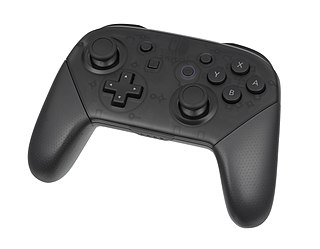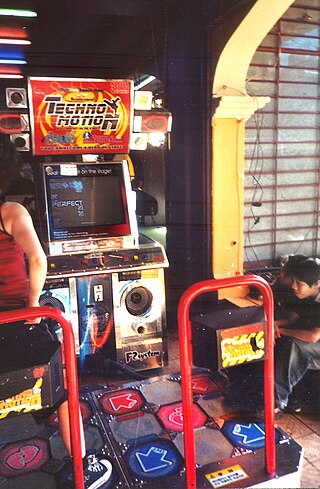Dance Dance Revolution (DDR) is a music video game series produced by Konami. Introduced in Japan in 1998 as part of the Bemani series, and released in North America and Europe in 1999, Dance Dance Revolution is the pioneering series of the rhythm and dance genre in video games. Players stand on a "dance platform" or stage and hit colored arrows laid out in a cross with their feet to musical and visual cues. Players are judged by how well they time their dance to the patterns presented to them and are allowed to choose more music to play to if they receive a passing score.

A game controller, gaming controller, or simply controller, is an input device or input/output device used with video games or entertainment systems to provide input to a video game. Input devices that have been classified as game controllers include keyboards, mice, gamepads, and joysticks, as well as special purpose devices, such as steering wheels for driving games and light guns for shooting games. Controllers designs have evolved to include directional pads, multiple buttons, analog sticks, joysticks, motion detection, touch screens and a plethora of other features.

StepMania is a cross-platform rhythm video game and engine. It was originally developed as a clone of Konami's arcade game series Dance Dance Revolution, and has since evolved into an extensible rhythm game engine capable of supporting a variety of rhythm-based game types. Released under the MIT License, StepMania is open-source free software.
Bemani, stylized as BEMANI, is Konami's music video game division. Originally named the Games & Music Division (G.M.D.), it changed its name in honor of its first and most successful game, Beatmania, and expanded into other music-based games, most notably rhythm games such as Dance Dance Revolution, GuitarFreaks, and DrumMania.

A gamepad is a type of video game controller held in two hands, where the fingers are used to provide input. They are typically the main input device for video game consoles.

Pump It Up is a music video game series developed and published by Andamiro, a Korean arcade game producer. The game is similar to Dance Dance Revolution, except that it has five arrow panels as opposed to four, and is typically played on a dance pad with five arrow panels: the top-left, top-right, bottom-left, bottom-right, and a center. Additional gameplay modes may utilize two five-panel pads side by side. These panels are pressed using the player's feet, in response to arrows that appear on the screen in front of the player. The arrows are synchronized to the general rhythm or beat of a chosen song, and success is dependent on the player's ability to time and position their steps accordingly.

A dance pad, also known as a dance mat or dance platform, is a flat electronic game controller used for input in dance games. Most dance pads are divided into a 3×3 matrix of square panels for the player to stand on, with some or all of the panels corresponding to directions or actions within the game. Some dance pads also have extra buttons outside the main stepping area, such as "Start" and "Select". Pairs of dance pads often are joined, side by side, for certain gameplay modes.

TechnoMotion is a Korean music video game. As in other games that use dance pads, such as Dance Dance Revolution, a player must press panels in response to scrolling arrows on the game's monitor.
This is a comparison of dancing video game series in which players must step on panels on a dance pad in time with music. Step placement and timing is indicated by rising arrows overlapping fixed targets.
Dance Dance Revolution ULTRAMIX 3 is a music video game developed by Konami and the tenth entry of Dance Dance Revolution released in the United States. It was released on November 15, 2005 for the Xbox. About 70 songs are available in total in this version. The game was announced in a press release by Konami on May 17, 2005, and unveiled at the E³ expo in Los Angeles that same day.
A video game accessory is a distinct piece of hardware that is required to use a video game console, or one that enriches the video game's play experience. Essentially, video game accessories are everything except the console itself, such as controllers, memory, power adapters (AC), and audio/visual cables. Most video game consoles come with the accessories required to play games out of the box : one A/V cable, one AC cable, and a controller. Memory is usually the most required accessory outside of these, as game data cannot be saved to compact discs. The companies that manufacture video game consoles also make these accessories for replacement purposes as well as improving the overall experience. There is an entire industry of companies that create accessories for consoles as well, called third-party companies. The prices are often lower than those made by the maker of the console (first-party). This is usually achieved by avoiding licensing or using cheaper materials. For the mobile systems like the PlayStation Portable and Game Boy iterations, there are many accessories to make them more usable in mobile environments, such as mobile chargers, lighting to improve visibility, and cases to both protect and help organize the collection of system peripherals to. Newer accessories include many home-made things like mod chips to bypass manufacturing protection or homemade software.

The Xbox 360 controller is the primary game controller for Microsoft's Xbox 360 home video game console that was introduced at E3 2005. The Xbox 360 controller comes in both wired and wireless versions. The Xbox controller is not compatible with the Xbox 360. The wired and wireless versions are also compatible with Microsoft PC operating systems, such as Windows XP, Windows Vista, Windows 7, Windows 8, Windows 10, and Windows 11.

The PlayStation 2 (PS2) is a home video game console developed and marketed by Sony Interactive Entertainment. It was first released in Japan on 4 March 2000, in North America on 26 October 2000, in Europe on 24 November 2000, and in Australia on 30 November 2000. It is the successor to the original PlayStation, as well as the second installment in the PlayStation brand of consoles. As a sixth-generation console, it competed with Nintendo's GameCube, Sega's Dreamcast, and Microsoft's Xbox. It is the best-selling video game console of all time, having sold over 155 million units worldwide.
GameCube accessories include first-party releases from Nintendo, and third-party devices, since the GameCube's launch in 2001.

The Xbox is a home video game console manufactured by Microsoft that is the first installment in the Xbox series of video game consoles. It was released as Microsoft's first foray into the gaming console market on November 15, 2001, in North America, followed by Australia, Europe and Japan in 2002. It is classified as a sixth-generation console, competing with Sony's PlayStation 2 and Nintendo's GameCube. It was also the first major console produced by an American company since the release of the Atari Jaguar in 1993.

Dance Dance Revolution, released in Europe as Dance Dance Revolution Hottest Party 4 for the Wii version and Dance Dance Revolution New Moves for other versions, is a music video game in the Dance Dance Revolution series, with this entry developed by Konami's American division. Unveiled at E3 2010, it was released for the Wii and PlayStation 3 in North America on November 16, 2010. A port of this version for the Xbox 360 was also released on April 12, 2011. It is also the only game in the series to be released for the PlayStation 3, as well as the final game in the series to be released for the Xbox 360.
Various accessories for the PlayStation 2 video game console have been produced by Sony, as well as third parties. These include controllers, audio and video input devices like microphones and video cameras, and cables for better sound and picture quality.
Rhythm game accessories are often required to play rhythm games available for various consoles, such as the PlayStation 2, PlayStation 3, Wii, and Xbox 360. These include dance pads, guitar controllers, drum controllers, microphones and turntable controllers. With the exception of microphones, these controllers can generally be used to control any game, but have limited inputs, making them impractical for most games.

The Xbox Adaptive Controller (XAC) is a video game controller designed by Microsoft for Windows PCs and the Xbox One and Xbox Series X/S video game consoles. The controller was designed for people with disabilities to help make user input for video games more accessible.

Amazon Luna is a cloud gaming platform developed and operated by Amazon. Available only in the United States, United Kingdom, Canada, Germany, France, Italy, and Spain, the platform is powered by Amazon Web Services, has integration with Twitch, and is available on Windows, Mac, Amazon Fire TV, iOS as well as Android. Luna offers access to a selection of games via the Luna+ subscription as well as to channels from brands such as Ubisoft+ and Jackbox Games.











